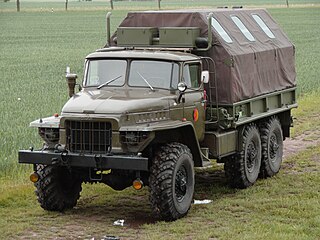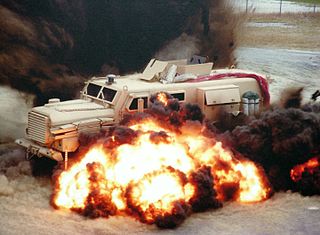
The High Mobility Multipurpose Wheeled Vehicle is a family of light, four-wheel drive, military trucks and utility vehicles produced by AM General. It has largely supplanted the roles previously performed by the original jeep, and others such as the Vietnam War-era M151 Jeep, the M561 "Gama Goat", their M718A1 and M792 ambulance versions, the Commercial Utility Cargo Vehicle, and other light trucks. Primarily used by the United States military, it is also used by numerous other countries and organizations and even in civilian adaptations. The Humvee saw widespread use in the Gulf War of 1991, where it navigated the desert terrain; this usage helped to inspire civilian Hummer versions. The vehicle's original unarmored design was later seen to be inadequate, and was found to be particularly vulnerable to improvised explosive devices in the Iraq War. The U.S. hastily up-armored select models and replaced front-line units with the MRAP. Under the Joint Light Tactical Vehicle (JLTV) program, in 2015 the U.S. Army selected the Oshkosh L-ATV to replace the vehicle in front-line U.S. military service.

The RG-31 Nyala is a 4×4 multi-purpose mine-resistant ambush protected infantry mobility vehicle manufactured in South Africa by Land Systems OMC, located in Benoni, South Africa and in Turkey by FNSS Defence Systems. It is based on the Mamba APC of TFM Industries.

The ZU-23-2, also known as ZU-23, is a Soviet towed 23×152mm anti-aircraft twin-barreled autocannon. ZU stands for Zenitnaya Ustanovka – anti-aircraft mount. The GRAU index is 2A13.

The Medium Tactical Vehicle Replacement (MTVR) is a series of vehicles used by the U.S. Marines. The first MTVRs were delivered in late 1999. The MTVR is the equivalent of the U.S. Army's Family of Medium Tactical Vehicles (FMTV); the Marines do not use the FMTV and the Army does not use the MTVR.

The 9M113 Konkurs is a Soviet SACLOS wire-guided anti-tank missile.

The Family of Medium Tactical Vehicles (FMTV) are a series of military vehicles based upon a common chassis, varying by payload and mission requirements. The FMTV is derived from the Austrian Steyr 12M18 truck, but substantially modified to meet United States Army requirements. These include a minimum 50 percent U.S. content.

The Cougar is a mine-resistant ambush-protected (MRAP) and infantry mobility vehicle structured to be resistant to landmines and improvised munitions.

The Ural-375 is a general purpose 4.5 ton 6×6 truck produced at the Ural Automotive Plant in the Russian SFSR from 1961 to 1993. The Ural-375 replaced the ZIL-157 as the standard Soviet Army truck in 1979, and was replaced by the Ural-4320.
Armor Holdings, Inc. was an American manufacturer of military, law enforcement, and personnel safety equipment. It was acquired by BAE Systems on July 31, 2007 and renamed BAE Systems Mobility & Protection Systems. The divisions have been reorganised within BAE Systems Land and Armaments.

The RG-33 is a mine-resistant light armored vehicle initially designed by BAE Systems Land Systems South Africa, a South African subsidiary of BAE Systems. BAE Systems in the US extensively modified it with additional protection, new powertrain, and suspension systems. It was built in a number of locations including York, Pennsylvania. It was one of several vehicles being fielded by the US Armed Forces in Iraq under the MRAP program.

An infantry mobility vehicle (IMV) is a wheeled armored personnel carrier (APC) serving as a military patrol, reconnaissance or security vehicle. Examples include the ATF Dingo, Iveco LMV, Oshkosh M-ATV, AMZ Dzik, AMZ Tur, Mungo ESK, and Bushmaster IMV. This term also applies to Mine-Resistant Ambush Protected (MRAP) vehicles.

Mine-Resistant Ambush Protected is a term for United States military light tactical vehicles produced as part of the MRAP program that are designed specifically to withstand improvised explosive device (IED) attacks and ambushes. The United States Department of Defense MRAP program began in 2007 as a response to the increased threat of IEDs during the Iraq War. From 2007 until 2012, the MRAP program deployed more than 12,000 vehicles in the Iraq War and War in Afghanistan.

The International M1224 MaxxPro MRAP is an armored fighting vehicle designed by American company Navistar International's subsidiary Navistar Defense along with the Israeli Plasan Sasa, who designed and manufactures the vehicle's armor. The vehicle was designed to take part in the US military's Mine Resistant Ambush Protected vehicle program, led by the US Marine Corps, as well as a similar US Army-led Medium Mine Protected Vehicle program.
The Bull is an armored personnel carrier with a v-shaped hull designed in a combined effort between Ceradyne, Ideal Innovations Inc. (I-3), and Oshkosh Corporation in response to the MRAP II competition. "The Bull" is a trade-mark of Ideal Innovations, Inc. (I-3).

The GFF4, previously KMW Grizzly, is a medium weight MRAP armored personnel carrier, developed by Krauss-Maffei Wegmann (KMW), designed for operation with the German Army based on the 6x6 Trakker chassis from Iveco adapted to meet the needs of the German Army. It is being developed under the direction of the German Ministry of Defence Federal Office of Defense Technology and Procurement. The GFF4 is designed to meet the German Army's "Class 4" protected command and role-specific vehicles, with a gross vehicle weight of 25 tons, and transportable on the Airbus A400M aircraft. Currently, the German Army could use only the smaller 12.5 ton ATF Dingo 2 or the 33 ton Boxer MRAV.

The 9K115-2 Metis-M is a Russian portable anti-tank guided missile system. "9K115-2" is the GRAU designation of the missile system. The Metis-M1 is the latest upgraded variant of Metis-M. The system is designed to augment the combat power of company-level motorized units.

The Oshkosh M-ATV is a mine-resistant ambush protected (MRAP) vehicle developed by the Oshkosh Corporation for the MRAP All Terrain Vehicle (M-ATV) program. Intended to replace M1114 HMMWVs (Humvee), it is designed to provide the same levels of protection as the larger and heavier previous MRAPs, but with improved mobility.

Safir is an Iranian 4x4 multipurpose military vehicle built by Fath Vehicle Industries. The Safir weighs 1.5 tonne and is based on the M38. The jeep can be distinguished from the M38 due to the sharp angled body panels, hood and grille.

BMC Kirpi is a Turkish made Mine-Resistant Ambush Protected vehicle manufactured by BMC. Kirpi provides significant protection against mine and ballistic threats. It combines standard and add-on armor providing protection against ballistic threats. Its V-shape underbody and monocoque allows it to protect the personnel inside from land mines and improvised explosive devices (IEDs).

The IAG Guardian is a United Arab Emirates-made armored personnel vehicle. It was developed by the International Armored Group company. It's available in 4x4 and 6x6 configurations. This vehicle has been used in the Middle East conflict and has been marked as battle proven to participate in low intensity conflicts.





















